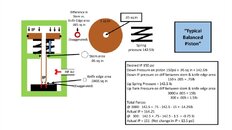@DA Aquamaster what do you mean "that area is not addressed by the diameter of the piston where it passes through the high pressure piston stem o-ring"?
Why is that making it unbalanced?
Although the sizes of the areas in question are exaggerated for visual purposes, and the dimensions are arbitrary, perhaps this picture will make sense of the cause for slight unbalancing due to the slightly decreased diameter of the seating edge, compared with the stem diameter.

As these pics show, a "knife edge" isn't a knife edge:
As Pete Wolfinger's Regulator Savvy discusses, that few thousandths difference in OD vs knife edge contact circle is several psi of imbalance between 3000 and 300 tank pressure.
Think of it as little tiny tank gremlins hooking their fingers under that tiny curve and lifting up on the piston. If the side of the piston stem were perfectly straight, with an absolutely perfect knife edge contacting the seat, the gremlins couldn't get their fingers underneath, and the reg would be balanced.
In the case of the Mark 25, the very end of the piston stem has an increased diameter. Think of the gremlins as standing on the shoulder of that increased diameter and jumping down to increase the force on the seat. At the same time there is a second set of gremlins lifting up on the curve at the bottom edge, and they cancel each other out.
Because the circle where the enlarged knife edge contacts the seat is exactly the same size as the piston stem, it's as though the piston stem were perfectly straight with a perfect knife edge, and the reg is closer to perfectly balanced.





